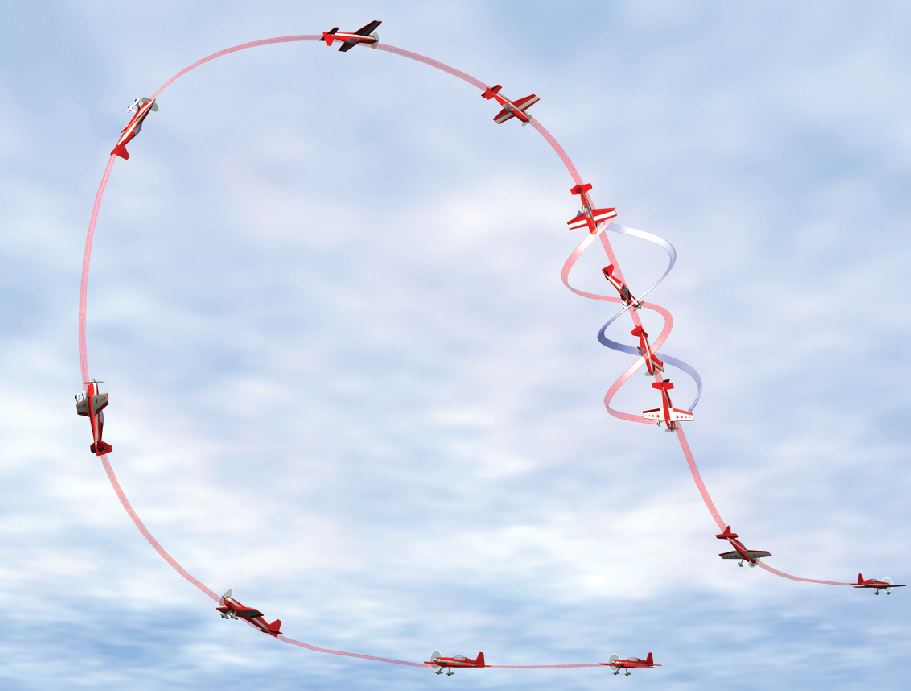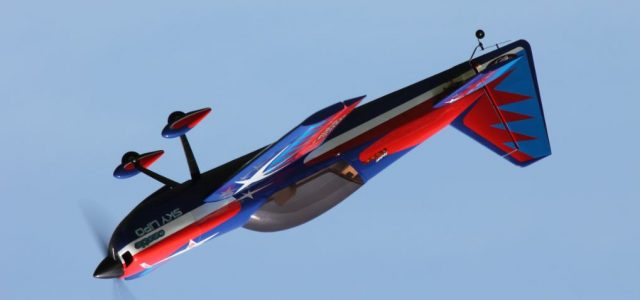In the past, we’ve discussed different aerobatic moves that consist of endless variations of a basic maneuver. Let’s take a look at another variation of the basic Cuban-8, this time making it a half Cuban-8 with 1 1/2 negative snap rolls. As performed by Aerobatics Made Easy columnist John Glezellis, the half Cuban-8 is usually performed with a half-roll on the down-line, but John spices things up by replacing the roll segment with a more impressive, 1 1/2 negative snap roll, (starting from inverted to end in the usual up upright position.) With a strong aerobatic foundation, this maneuver is a great deviation from the norm. Let’s get started!
 Let’s first examine radio and aircraft setup. It is very important to spend extra time in your workshop to ensure proper setup before taking to the skies. On a maneuver like this one that combines a rather elegant maneuver with a harsh element (the 1 1/2 negative snap), you have to use dual rates. I also recommend using Flight Modes (assigning all dual and/or triple rates to one specific switch). Doing this greatly minimizes pilot workload, allowing you more time to focus on performing the maneuver and less time looking for switches!
Let’s first examine radio and aircraft setup. It is very important to spend extra time in your workshop to ensure proper setup before taking to the skies. On a maneuver like this one that combines a rather elegant maneuver with a harsh element (the 1 1/2 negative snap), you have to use dual rates. I also recommend using Flight Modes (assigning all dual and/or triple rates to one specific switch). Doing this greatly minimizes pilot workload, allowing you more time to focus on performing the maneuver and less time looking for switches!
For this maneuver I use low-rate settings for the looping portion of the maneuver, which is about 25-percent aileron expo, 25-percent elevator expo, and 30-percent rudder expo with about 20 degrees of aileron deflection, 15 degrees of elevator deflection, and 30 degrees of rudder deflection. Then, when for the snap roll, I use about 50-percent expo on both the ailerons and elevator control surfaces and about 55 percent of rudder expo with 35 degrees of aileron deflection, 20 degrees of elevator deflection, and about 40 degrees of rudder deflection on my next rate.
Since this maneuver includes 1 1/2 negative snaps, keep in mind that all airplanes perform differently. If you find that your particular airplane performs the snap too quickly for you to keep up with, pull back on the dual rate values to slow it down. Some airplanes have differing rotation speeds due to too much rudder throw. I have flown a few giant-scale Cap 232s and have noticed that too much rudder greatly affects rotation rates. Other airplanes may offset their flight path quite a bit, which also means you have too much rudder. Also, if your airplane gets too deep in pitch, decrease the amount of elevator deflection.
Once flying, if at maximum aileron stick deflection the roll rate is too slow, increase the dual rate for that given rate. If roll rate is difficult to manage, decrease the amount of deflection in that particular setting. Similarly, if the airplane is too responsive around neutral but the endpoint value is great (the dual rate value), increase the exponential you are using. It will take time to dial in your airplane, but the effort is well worth it. Always remember, that what works for one airplane may not work for another.
If you find that your airplane does not perform the snapping segment with easy and changes rotation speed, you may be experiencing blowback. This means that even though your aircraft has a certain fixed deflection on the ground, it may have less deflection during flight. Simply said, this means that a pushrod is flexing on a given surface or, you may not have servos that aren’t powerful enough. Use stiffer pushrods and upgrade those servos.
 If you’re flying Inverted or upright, always concentrate on “wings level.”
If you’re flying Inverted or upright, always concentrate on “wings level.”
Whether you are flying a park flyer or a giant-scale unlimited aerobat, always remember to perform new maneuvers at a safe altitude you’re comfortable with. Stay in your comfort zone. If you are not yet proficient with snaps, start at a higher altitude like 150 feet for a typical 50-inch electric park flyer or 400 feet for a giant aerobat. Select your entry altitude, fly your aircraft parallel to the runway and increase your throttle to about 75 percent power.
FLYING THE MANEUVER
The half Cuban-8 begins in upright level flight then the pilot pulls from upright level flight to establish a 45-degree down-line. Once a brief line segment is flown, the 1 1/2 negative snap rolls are executed. Another line segment that’s equal to the first is then flown before the pull to bring the aircraft back to upright level flight at the same altitude in which it began but travelling in the opposite direction!
STEP 1: Increase throttle to max power. If the aircraft you are flying is highly overpowered, use slightly less power. Begin to pull back ever so slightly while using low rates on elevator to initiate a graceful 1/2 loop.
STEP 2: As the model nears the top, begin to decrease the throttle, establish an inverted 45-degree down line then stop pulling up elevator. Define the 45-degree down-line with a brief line segment, (about two seconds in length) then flip to your medium or high rate settings to prepare for the snapping portion of the maneuver.
STEP 3: Perform the 1 1/2 negative snaps by applying opposite aileron input to rudder input and down elevator. Use full right aileron and left rudder and down-elevator input to perform the negative snap to the right. Then, stop the aircraft upright on the 45-degree down-line. Fly another brief line segment, equal to first one.
STEP 4: Flip back to low rate setting and perform a smooth and constant radius to level upright flight. Remember, exit at the same altitude you began with, so keep an eye on your altitude. To perfect the maneuver, practice again and again! After all, practice makes perfect!
Take your time, and if you find that you are consistently having difficulty performing this stunt, break the maneuver down to its basic components, check the model’s setup and seek an experienced pilot for help.
























Thank you, good information. How about taking us through the Circus 8—-1-1/2 snaps in the center of the 45 deg. up line.